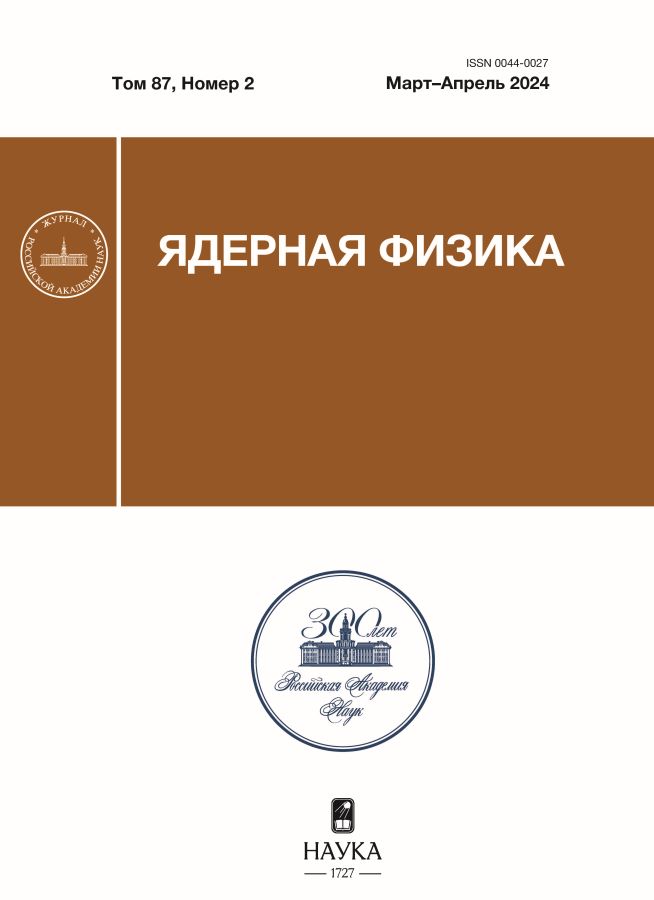Features of Forbush decreases according to satellite and ground based detectors
- 作者: Lagoida I.A.1, Voronov S.A.1, Mikhailov V.V.1
-
隶属关系:
- National Research Nuclear University ‟MEPhI” (Moscow Engineering Physics Institute)
- 期: 卷 87, 编号 2 (2024)
- 页面: 86-90
- 栏目: ЭЛЕМЕНТАРНЫЕ ЧАСТИЦЫ И ПОЛЯ. Эксперимент
- ##submission.datePublished##: 07.10.2024
- URL: https://cardiosomatics.ru/0044-0027/article/view/674660
- DOI: https://doi.org/10.31857/S0044002724020036
- EDN: https://elibrary.ru/KRVVZK
- ID: 674660
如何引用文章
详细
Forbush decreases are sudden drops of cosmic ray intensity recorded by ground based and satellite detectors. This effect is strongly connected with coronal mass ejections from the Sun. Those are the massive eruptions of plasma material from the Sun atmosphere into interplanetary space. Coronal mass ejections affect cosmic ray particles while moving through interplanetary space causing Forbush decrease. In this work, we have studied the behavior of temporal profiles of cosmic ray intensity during Forbush decreases using data on cosmic proton fluxes recorded by the AMS-02 spectrometer during 2011 to 2019.
全文:
作者简介
I. Lagoida
National Research Nuclear University ‟MEPhI” (Moscow Engineering Physics Institute)
编辑信件的主要联系方式.
Email: IALagoida@mephi.ru
俄罗斯联邦, Moscow
S. Voronov
National Research Nuclear University ‟MEPhI” (Moscow Engineering Physics Institute)
Email: IALagoida@mephi.ru
俄罗斯联邦, Moscow
V. Mikhailov
National Research Nuclear University ‟MEPhI” (Moscow Engineering Physics Institute)
Email: IALagoida@mephi.ru
俄罗斯联邦, Moscow
参考
- S. E. Forbush, Phys. Rev. 51, 1108 (1937).
- N. Gopalswamy, Space Sci. Rev. 124, 145 (2006).
- A. V. Belov, E. A. Eroshenko, A. B. Struminsky, and V. G. Yanke, Adv. Space Res. 27, 625 (2001).
- I. G. Richardson and H. V. Cane, Sol. Phys. 270, 609 (2011).
- N. Iucci, M. Parisi, M. Storini, and G. Villoresi, Nuovo Cimento 2, 1 (1979).
- H. S. Hudson, J. L. Bougeret, and J. Burkepile, Space Sci. Rev. 123, 13 (2006).
- P. Picozza, A. M. Galper, G. Castellini, O. Andriani, F. Altamura, M. Ambriola, G. C. Barbarino, A. Basili, G. A. Bazilevskaja. R. Bencardino, M. Boezio, E. A. Bogomolov, L. Bonechi, M. Bongi, L. Bongiorno, V. Bonvicini, et al., Astropart. Phys. 27, 296 (2007).
- T. H. Zurbuchen and I. G. Richardson, Space Sci. Rev. 123, 31 (2006).
- I. G. Richardson and H. V. Cane, J. Geophys. Res. Space Phys. 100, 23397 (1995).
- H. V. Cane, Space Sci. Rev. 93, 55 (2000).
- J. A. Lockwood, Space. Sci. Rev. 12, 658 (1971).
- J. A. Lockwood, W. R. Webber, and J. R. Jokipii, J. Geophys. Res. Space Phys. 91, 2851 (1986).
- W. R. Webber, in Progress in Elementary Particle and Cosmic Ray Physics, Ed. by J. G. Wilson and S. A. Wouthuysen (North-Holland, Amsterdam, 1962), p. 75.
- G. Wibberenz, J. A. Le Roux, M. S. Potgieter, and J. W. Bieber, Space Sci. Rev. 83, 309 (1998).
- I. G. Usoskin, I. Braun, O. G. Gladysheva, J. R. Horandel, T. Jamsen, G. A. Kovaltsov, and S. A. Starodubsev, J. Geophys. Res. 113, A07102 (2008).
- L. Zhao and L. Zhang. Astrophys. J. 827, 13 (2016).
- R. Munini, M. Boezio, A. Bruno, E. C. Christian, G. A. de Nolfi, V. Di Felice, M. Martucci, M. Merge, I. G. Richardson, J. M. Ryan, S. Stochaj, O. Adriani, G. C. Barbarino, G. A. Bazilevskaya, R. Bellotti, M. Bongi, et al., Astrophys. J. 853, 11 (2018).
- F. Alemanno, Qi An, P. Azzarello, F. C. T. Barbato, P. Bernardini, B. XiaoJun, M. Cai, E. Casilli, E. Catanzani, J. Chang, D. Chen, J. Chen, Z. Chen, M. Cui, T. Cui, Y. Cui, et al., Astrophys. J. Lett. 920, L43 (2021).
- I. A. Lagoida, S. A. Voronov, V. V. Mikhailov, M. Boezio, R. Munini, C. Gustavino, G. A. Bazilevskaya, R. Belloti, E. A. Bogomolov, V. Bonvicini, F. Cafanga, D. Campana, M. Casolino, A. M. Galper, S. Koldobskiy, A. N. Kvashnin, et al., Sol. Phys. 298, 9 (2023).
- M. Aguilar, L. Ali Cavasonza, G. Ambrosi, L. Arruda, N. Attig, F. Barao, L. Barrin, A. Bartoloni, J. Bates, R. Battiston, M. Behlmann, B. Beischer, J. Berdugo, B. Bertucci, V. Bindi, W. de Boer, et al., Phys. Rev. Lett. 127, 271102 (2021).
- V. Domingo, B. Fleck, and A. I. Poland, Space Sci. Rev. 72, 81 (1995).
- K. W. Ogilvie and M. D. Desch, Adv. Space Res. 20, 559 (1997).
补充文件













